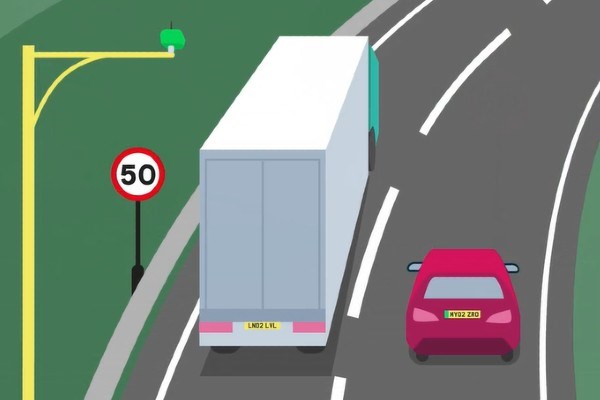
50mph schemes successful in driving down air pollution
Cynlluniau 50mph yn llwyddo i leihau llygredd aer
From 4 October, motorists exceeding the 50mph speed limits on some of the most polluted roads in Wales could receive a letter or fine through their doors, the Welsh Government has warned.
The decision to introduce environmental speed limits to improve air quality levels in five locations across Wales in 2018 was the first of its kind in the UK, demonstrating the Welsh Government’s commitment of putting the environment at the heart of everything it does.
The schemes have already been successful in significantly lowering the levels of nitrogen dioxide in affected areas by up to 47%, helping to protect people from serious illness as well as playing a part in tackling the climate emergency.
Air pollution is considered to be one of the largest environmental health risks of our generation, according to the World Health Organisation, increasing our risks of heart and lung disease and contributing towards the worsening of pre-existing health conditions such as asthma.
Deputy Minister for Climate Change, Lee Waters, who has a responsibility for Transport said:
“We've made significant progress in bringing emissions levels down in recent years, but we now have to go further and faster.
“We know that slower speed limits are not a popular choice, but we need to do things differently and be bold if we are to stand a chance of tackling climate change.
“It’s clear that the speed restrictions we’ve introduced on our most polluted roads are working - the results speak for themselves – but compliance with these limits is essential if we are to achieve the reductions we need to make in the shortest possible time.
“We need to act now to make Wales a safe place to live with clean air for everyone.”
South Wales Police, Roads Policing Lead for Wales, Assistant Chief Constable, Mark Travis commented:
“The implementation of the 50mph speed limits, for environmental reasons, on some of Wales’s busiest roads is an important issue to tackle pollution and to give Wales and its communities a cleaner and healthier future.
“All four Welsh Forces are supporting its implementation, with the enforcement of these speed limits approached in a consistent, proportionate and transparent manner.”
GoSafe Partnership Manager, Teresa Ciano, added:
“Driving at the posted speed limit has benefits for safety, but it can also improve our lives in other ways. By supporting the Welsh Government's ambition to improve air quality for Wales, we know our roads will be safer too. By implementing a first of its kind advisory letter programme, we will be able to inform people of the importance of complying with the speed limit at these locations, whilst still prosecuting the most dangerous drivers.”
Notes to editors
The roads which are affected by the 50mph speed restrictions and enforcement measure include:
- A494 Wales/England border to St David’s Interchange, Deeside;
- A483 Junction 5 to Junction 6, Wrexham;
- A470 Upper Boat Interchange to Bridge Street Interchange, Pontypridd;
- M4 Junction 41 to Junction 42, Port Talbot;
- M4 Junction 25 to Junction 26, Newport – a change from variable speed limit enforced by spot speed cameras to a permanent 50mph to be enforced by Average Speed Enforcement at a future date.
Statistics:
|
Annual mean NO2 concentrations (µg/m3) |
|||||
|
|
2018 Annual Mean |
2019 Annual Mean |
Percentage difference 2018 to 2019 |
2020 Annual Mean |
Percentage difference 2018 to 2020 |
|
A483 Wrexham - North Wales |
50.2 |
40.9 |
-18.53% |
27.5 |
-45.22% |
|
A494 Deeside - North Wales |
42.2 |
36.6 |
-13.27% |
26.5 |
-37.20% |
|
A470 Pontypridd - South Wales |
56.8 |
48.1 |
-15.32% |
30.5 |
-46.30% |
|
M4 Newport - South Wales |
63.5 |
59.2 |
-6.77% |
38.4 |
-39.53% |
|
M4 Port Talbot - South Wales |
48.4 |
43.0 |
-11.16% |
28.2 |
-41.74% |
Note:
Data recorded via diffusion tubes and adjusted using national bias adjustment factors
50mph speed limits have been in operation since June 2018
- The 47% reduction relates to the greatest difference in values when comparing nitrogen dioxide concentrations recorded at the roadside before and after implementation of the 50mph speed limit and includes data up until the end of 2019.
- Data recorded for 2020 and the early part of 2021 has indicated that concentrations of nitrogen dioxide at all five locations have generally remained below the legal limit of 40µg/m³, principally as a result of lower traffic flows associated with the Covid-19 pandemic. Traffic flows have now started to return to pre-pandemic levels and it is hoped that with better compliance with the speed limit, we will maintain the positive improvements in air quality at all 5 locations.
- The enforcement of the environmental 50mph limit is focused on action required to meet our legal limits for nitrogen dioxide. This is one part of a wide range of work we are undertaking with Government departments and sectors, and the public, to drive forward ambitious action to reduce exposure to air pollution in our Clean Air Plan for Wales.
- This includes a combination of evidence based policy, legislation, guidance, regulations and investment to reduce air pollution. For example, we are developing and delivering sustainable infrastructure, planning guidance and travel choices.
Research:
Research conducted by the European Environment Agency and Welsh Government has showed that reducing traffic speeds to around 50 mph has produced significant reductions in pollution, because it:
- Improves and reduces fuel consumption, which then creates less pollutant gases.
- Promotes consistent speeds, which produces less braking and accelerating, reducing pollution.
- Reduces turbulence and the spread of road dust and particulate matter suspended in the air.
Visit the Welsh Government website for more information: https://gov.wales/50mph-speed-limits-to-reduce-pollution
